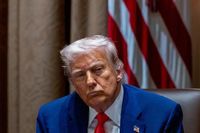In a surprising turn of events, U.S. President Donald Trump announced on April 9, 2025, that he would temporarily suspend tariffs on nearly 60 countries and the European Union for a period of 90 days. This decision came just hours before the tariffs were set to take effect, leading to a significant surge in the stock market, with the S&P 500 index climbing 9.5%—the largest single-day gain since 2008. Despite this temporary reprieve for many nations, the trade war with China intensified, as Trump simultaneously raised tariffs on Chinese goods from 104% to an astonishing 125%.
Trump's announcement marked a dramatic shift in his approach to international trade, which has been characterized by a series of unpredictable decisions. The tariffs, originally proposed on April 5, 2025, were designed to be reciprocal, targeting countries based on their trade surplus with the U.S. However, the recent suspension means that products imported from the affected countries will now face a uniform tariff of 10%. Notably, China was excluded from this suspension, with Trump reiterating his commitment to increasing tariffs on Chinese imports.
In response to Trump's tariff policies, Beijing declared plans to impose 84% tariffs on U.S. goods, escalating tensions between the two largest economies in the world. The World Trade Organization (WTO) has warned that the ongoing trade dispute poses a significant risk of a sharp contraction in bilateral trade between the U.S. and China, with initial forecasts suggesting a potential decrease of up to 80% in trade volume.
During a White House celebration for NASCAR Cup Series champion Joey Logano, Trump described his approach to tariffs as being “more based on instinct than anything else,” acknowledging the unease felt by some investors regarding the economic volatility his policies have created. He expressed optimism about the financial markets, stating, “They (stock prices) will change,” and highlighted that the recent market rebound followed his latest tariff adjustments.
Trump's assertion that “many other countries—well over 75—want to come in” for business reflects his belief that the U.S. will benefit from these negotiations by the end of the year. He also warned countries that retaliate against U.S. tariffs that they would face doubled tariffs, a clear indication of his aggressive stance towards trade negotiations.
As the trade relationship between the U.S. and China continues to evolve, it's important to note that China remains the U.S.'s third-largest trading partner, following Mexico and Canada. In 2024, total goods trade between the two nations was estimated at $582.4 billion, with the U.S. exporting $143.5 billion and importing $438.9 billion from China. The U.S. trade deficit with China has increased by 5.8% compared to the previous year, standing at $295.4 billion.
Despite the ongoing tensions, the U.S. has been gradually reducing its reliance on Chinese imports, with Chinese goods accounting for 13.3% of total U.S. imports in 2024, down from a peak of 21.6% in 2017. Machinery and equipment constituted a significant portion of these imports, making up 46.4% of the total in 2022.
Trump has long maintained that tariffs can help reduce the U.S. trade deficit and bring manufacturing jobs back to America. However, economists like Vincent Vicard from CEPII have cautioned that while certain industries, such as automotive and steel, may benefit from reduced foreign competition, they will also face higher prices for intermediate goods. This could lead to increased costs for consumers and a potential rise in inflation, which is already projected to increase from the current rate of 2.8%.
On April 10, 2025, the White House clarified that the minimum tariff rate on all Chinese goods imported into the U.S. is now 145%. This figure includes a 125% tariff imposed after China's retaliatory measures, along with a 20% tariff related to China's supply of fentanyl to the U.S. The rapid changes in tariff rates have created confusion among importers, many of whom depend on Chinese products. The difference between a 125% and a 145% tariff could result in tens of thousands of dollars for importers.
During a press conference on April 11, 2025, Chinese Foreign Ministry spokesperson Lin Jian reiterated China's position, stating that there are no winners in trade wars and emphasizing that China is unwilling to engage in a tariff battle but will not shy away from defending its interests. Lin called for dialogue based on equality and warned that if the U.S. persists in its aggressive tariff policies, China would respond accordingly.
As the situation develops, the potential for a resolution remains uncertain. Trump has hinted at the possibility of extending the 90-day suspension period if agreements can be reached, but he also threatened to revert to original tariff levels if negotiations fail. With both sides holding firm, the future of U.S.-China trade relations hangs in the balance.







